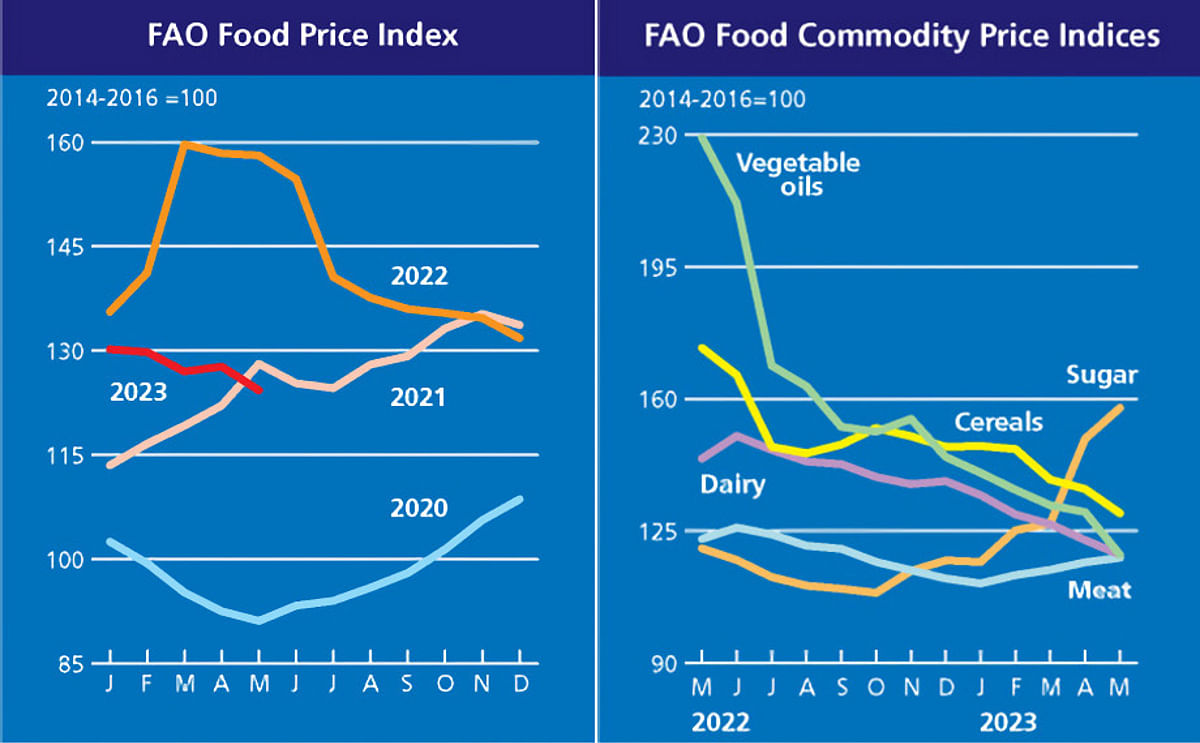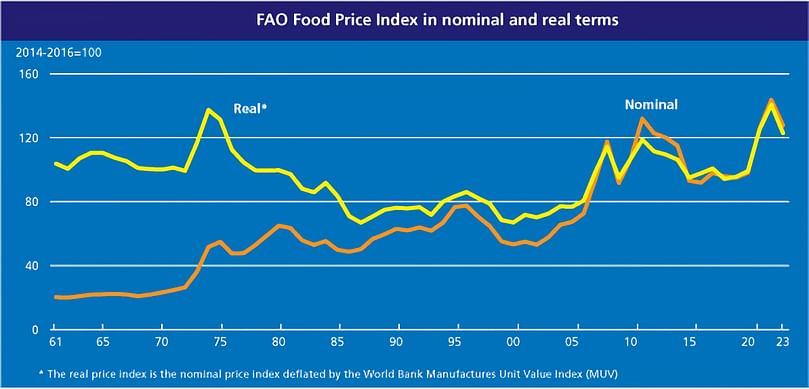The FAO Food Price Index back to its downward trend in May
Primaire tabs
The FAO Food Price Index back to its downward trend in May

The FAO Food Price Index* (FFPI) averaged 124.3 points in May 2023, down 3.4 points (2.6 percent) from April and as much as 35.4 points (22.1 percent) from the all-time high it reached in March 2022.
The decline in May was underpinned by significant drops in the price indices for vegetable oils, cereals and dairy, which were partly counterbalanced by increases in the sugar and meat indices.
The FAO Cereal Price Index averaged 129.7 points in May, down 6.5 points (4.8 percent) from April and as much as 43.9 points (25.3 percent) below its record-high value one year ago. International wheat prices declined by 3.5 percent month-on-month, reflecting prospects for ample global supplies in the upcoming 2023/24 season and the extension of the Black Sea Grain Initiative.
World maize prices fell by 9.8 percent in May. A favourable outlook for 2023/24 pointing to a rebound in global supplies, with higher production expected in Brazil and the United States of America, two major exporters, weighed on prices. A slow pace of exports by the United States of America, along with cancelled purchases by China, also exerted downward pressure on world maize prices.
Among other coarse grains, world prices of barley and sorghum also declined, by 9.5 percent and 9.7 percent, respectively, influenced by declines in international maize and wheat prices. By contrast, international prices of rice continued to increase in May, as previous deals with Asian buyers were executed and supplies tightened in some exporters, such as Viet Nam and Pakistan.
The FAO Vegetable Oil Price Index averaged 118.7 points in May, down 11.3 points (8.7 percent) month-on-month and standing as much as 48.2 percent below its year-earlier level. The continued decline in the index reflected lower world prices across palm, soy, rapeseed and sunflower oils.
International palm oil prices fell markedly from April, as protracted weak global import purchases coincided with expectations of rising outputs in major producing countries. In the meantime, world soyoil prices dropped for the sixth consecutive month, largely underpinned by the persistent pressure from a bumper soybean crop in Brazil and higher-than-expected stocks in the United States of America, where higher supplies of alternative feedstock partially replaced the uptake from the biodiesel industry. As for rapeseed and sunflower oils, international prices continued to decline on ample global supplies.
The FAO Dairy Price Index averaged 118.7 points in May, down 3.9 points (3.2 percent) from April and standing 25.5 points (17.7 percent) below its corresponding value in 2022. The decline in May was led by a steep drop in international cheese prices, principally due to ample export availabilities, including from inventories, amid seasonally high milk production in the northern hemisphere.
Following 10 monthly consecutive declines, international price quotations for milk powders rebounded, reflecting an upturn in purchases by North Asian buyers and seasonally falling milk supplies in Oceania. Meanwhile, butter prices rose slightly, as increased price quotations for supplies from Oceania, due to high purchases by Southeast Asian buyers and seasonally falling milk supplies, were almost offset by a decline in European prices on high export availabilities.
The FAO Meat Price Index* averaged 117.9 points in May, up 1.1 points (1.0 percent) from April, marking the fourth consecutive monthly increase, but still 5.0 points (4.1 percent) below its value in the corresponding month last year. International poultry meat prices increased further in May, driven by the continued high import demand, especially from Asia, and some concerns over potential short-term supply challenges due to widespread avian flu outbreaks.
World bovine meat prices increased slightly, underpinned by higher global demand for Brazilian supplies and persistent supply tightness in the United States of America, despite the continued high cattle slaughter in Australia.
Pig meat prices rose for the fourth successive month, although only marginally, as supply limitations stemming from high production costs and animal diseases elsewhere boosted demand for Brazilian supplies. Meanwhile, world ovine meat prices fell on high export availabilities from Oceania.
The FAO Sugar Price Index averaged 157.6 points in May, up 8.2 points (5.5 percent) from April, marking the fourth consecutive monthly increase, and as much as 37.3 points (30.9 percent) above its value a year ago. Rising concerns over how the development of the El Niño phenomenon may affect the 2023/24 crops, together with lower-than-earlier-expected global availabilities in the 2022/23 season, triggered the increase in international sugar prices in May.
Shipping delays amid strong competition from soybean and maize in Brazil also supported the increase in world sugar prices. However, the positive outlook for the 2023 sugarcane crops in Brazil, along with improved weather conditions benefiting the progress of the harvest, prevented larger monthly price gains. Lower international crude oil prices and a cut in fuel prices in Brazil further contributed to limiting the month-on-month increase in world sugar prices.

The decline in May was underpinned by significant drops in the price indices for vegetable oils, cereals and dairy, which were partly counterbalanced by increases in the sugar and meat indices.
The FAO Cereal Price Index averaged 129.7 points in May, down 6.5 points (4.8 percent) from April and as much as 43.9 points (25.3 percent) below its record-high value one year ago. International wheat prices declined by 3.5 percent month-on-month, reflecting prospects for ample global supplies in the upcoming 2023/24 season and the extension of the Black Sea Grain Initiative.
World maize prices fell by 9.8 percent in May. A favourable outlook for 2023/24 pointing to a rebound in global supplies, with higher production expected in Brazil and the United States of America, two major exporters, weighed on prices. A slow pace of exports by the United States of America, along with cancelled purchases by China, also exerted downward pressure on world maize prices.
Among other coarse grains, world prices of barley and sorghum also declined, by 9.5 percent and 9.7 percent, respectively, influenced by declines in international maize and wheat prices. By contrast, international prices of rice continued to increase in May, as previous deals with Asian buyers were executed and supplies tightened in some exporters, such as Viet Nam and Pakistan.
The FAO Vegetable Oil Price Index averaged 118.7 points in May, down 11.3 points (8.7 percent) month-on-month and standing as much as 48.2 percent below its year-earlier level. The continued decline in the index reflected lower world prices across palm, soy, rapeseed and sunflower oils.
International palm oil prices fell markedly from April, as protracted weak global import purchases coincided with expectations of rising outputs in major producing countries. In the meantime, world soyoil prices dropped for the sixth consecutive month, largely underpinned by the persistent pressure from a bumper soybean crop in Brazil and higher-than-expected stocks in the United States of America, where higher supplies of alternative feedstock partially replaced the uptake from the biodiesel industry. As for rapeseed and sunflower oils, international prices continued to decline on ample global supplies.
The FAO Dairy Price Index averaged 118.7 points in May, down 3.9 points (3.2 percent) from April and standing 25.5 points (17.7 percent) below its corresponding value in 2022. The decline in May was led by a steep drop in international cheese prices, principally due to ample export availabilities, including from inventories, amid seasonally high milk production in the northern hemisphere.
Following 10 monthly consecutive declines, international price quotations for milk powders rebounded, reflecting an upturn in purchases by North Asian buyers and seasonally falling milk supplies in Oceania. Meanwhile, butter prices rose slightly, as increased price quotations for supplies from Oceania, due to high purchases by Southeast Asian buyers and seasonally falling milk supplies, were almost offset by a decline in European prices on high export availabilities.
The FAO Meat Price Index* averaged 117.9 points in May, up 1.1 points (1.0 percent) from April, marking the fourth consecutive monthly increase, but still 5.0 points (4.1 percent) below its value in the corresponding month last year. International poultry meat prices increased further in May, driven by the continued high import demand, especially from Asia, and some concerns over potential short-term supply challenges due to widespread avian flu outbreaks.
World bovine meat prices increased slightly, underpinned by higher global demand for Brazilian supplies and persistent supply tightness in the United States of America, despite the continued high cattle slaughter in Australia.
Pig meat prices rose for the fourth successive month, although only marginally, as supply limitations stemming from high production costs and animal diseases elsewhere boosted demand for Brazilian supplies. Meanwhile, world ovine meat prices fell on high export availabilities from Oceania.
The FAO Sugar Price Index averaged 157.6 points in May, up 8.2 points (5.5 percent) from April, marking the fourth consecutive monthly increase, and as much as 37.3 points (30.9 percent) above its value a year ago. Rising concerns over how the development of the El Niño phenomenon may affect the 2023/24 crops, together with lower-than-earlier-expected global availabilities in the 2022/23 season, triggered the increase in international sugar prices in May.
Shipping delays amid strong competition from soybean and maize in Brazil also supported the increase in world sugar prices. However, the positive outlook for the 2023 sugarcane crops in Brazil, along with improved weather conditions benefiting the progress of the harvest, prevented larger monthly price gains. Lower international crude oil prices and a cut in fuel prices in Brazil further contributed to limiting the month-on-month increase in world sugar prices.
Unlike for other commodity groups, most prices utilized in the calculation of the FAO Meat Price Index are not available when the FAO Food Price Index is computed and published; therefore, the value of the Meat Price Index for the most recent months is derived from a mixture of projected and observed prices. This can, at times, require significant revisions in the final value of the FAO Meat Price Index which could in turn influence the value of the FAO Food Price Index. div>

The FAO Food Price Index rebounded slightly in April 2023
Like to receive news like this by email? Join and Subscribe!
Get the latest potato industry news straight to your WhatsApp. Join the PotatoPro WhatsApp Community!
Uitgelichte Bedrijven
Sponsored Content
Sponsored Content
Sponsored Content
Sponsored Content









